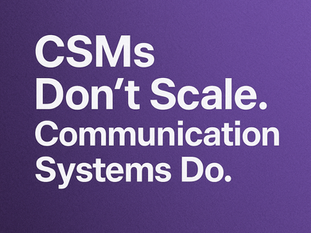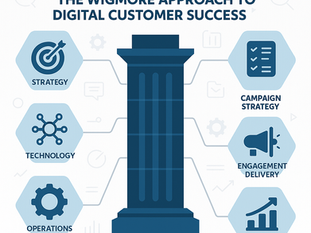
White Paper: Building a Concession Framework to Increase Renewals and Reduce Churn
Apr 16
4 min read
0
57
0
Executive Summary
In today’s volatile SaaS and technology market, protecting recurring revenue is more critical than ever. Customer Success (CS) leaders are often left scrambling when renewals are at risk, especially when external factors like procurement delays, economic pressures, or competitive threats come into play. The traditional response—last-minute discounts or pulling in Sales—is reactive and unsustainable.

This white paper introduces a Concession Framework: a proactive, strategic approach that empowers CS teams to address renewal threats with agility and structure, ensuring both customer success and long-term revenue health. The framework transforms concessions from chaotic giveaways into levers of mutual value.
1. What is a Concession Framework?
A Concession Framework is a structured, living strategy that balances two key outcomes:
● Protecting Annual Recurring Revenue (ARR) for your business
● Ensuring future success for your customer
Rather than defaulting to discounts, a Concession Framework helps organizations offer pre-approved, high-value, low-cost alternatives that support both parties' goals. It is not just about retaining logos—it's about sustaining relationships.
2. Why You Need a Concession Framework
Without a framework, CS teams typically respond to renewal risk in an ad hoc, emotional manner—often reacting with unnecessary discounts or pushing the problem to Sales.
Approach | Points |
CSM Reactive |
|
A well-built framework: |
|
3. The Concession Framework Blueprint
Step 1: Identify Concession Categories
Divide available concessions into three key buckets:
Bucket | Concessions |
A. Value (Product) |
|
B. Value (Service) |
|
C. Financial |
|
Step 2: Score Concessions
Use two dimensions to score every concession:
● Cost to Your Company (Low to High)
● Value to Your Customer (Low to High)
This allows you to plot each concession on a matrix and prioritize accordingly.
High customer value, low company cost = Best concessions to lead with Low customer value, high company cost = Avoid unless strategically necessary
Example Scored Concessions
Concession | Type | Value to Customer | Cost to Company | Strategic Use |
Add 10 User Seats | Product | High | Low | Lead with this (great trade-off) |
1 Free Month | Financial | High | Medium | Needs approval |
Upgrade to Next Package (free) | Product | High | High | Avoid unless critical |
Training Credits | Service | Medium | Low | Good long-term value |
Quarterly Billing Terms | Financial | Medium | Low | Easy win for Procurement |
Split Billing | Financial | Medium | Medium | Use for budget complexity |
60-Day Payment Terms | Financial | Medium | Medium | Requires CS Director approval |
2 Days Onsite Professional Services | Service | High | High | High cost - use with caution |
15% Discount | Financial | High | High | Needs VP approval |
Event Tickets | Service | Medium | Low | Relationship builder |
Step 3: Define Approval Levels
Concession Type | Senior CSM | Director of CS | VP of CS |
Payment Terms (45 Days) | Yes | Yes | Yes |
Payment Terms (60 Days) | No | Yes | Yes |
Payment Terms (90+ Days) | No | No | Yes |
Discount (up to 10%) | Yes | Yes | Yes |
Discount (20%+) | No | No | Yes |
Step 4: Build the Concession Decision Matrix
Use a two-axis matrix:
● X-axis: Cost to Company
● Y-axis: Value to Customer
Classify:
● Best Bets: High Value, Low Cost
● Strategic Bets: High Value, High Cost (needs approval)
● Easy Wins: Medium Value, Low Cost
● Avoid: Low Value, High Cost
Step 5: Operationalize It
● Document all available concessions and their approval thresholds
● Train CS teams on how and when to use concessions
● Integrate the framework into CRM/CS tools
● Review and refine quarterly based on data and feedback
4. Logo Retention and Maintenance Mode: A Strategic Last Resort
In times of macroeconomic disruption—such as a global recession, a pandemic, or political volatility like sudden tariffs or regulatory changes—customers may face pressures so intense that they consider fully terminating their contracts.
In these scenarios, the Concession Framework becomes more than a tool for negotiating flexible terms—it transforms into a retention firewall.
Why Logo Retention Matters
Even if the full value of the ARR cannot be preserved, retaining the logo is critical for long-term outcomes:
● Avoids the need for a new procurement cycle or vendor approval process later
● Preserves customer data, configuration, and usage history
● Maintains internal champions and relationships
● Increases likelihood of reactivation when market stabilizes
Maintenance Mode: What It Is
“Maintenance Mode” refers to a reduced contract status where the customer:
● Maintains limited access to key services (e.g., view-only dashboards, basic support)
● Pays a nominal fee (e.g., 10–20% of original ARR)
● Avoids full contract termination and stays within the vendor ecosystem
When to Use It
Maintenance Mode should only be applied when:
● The customer expresses intent to cancel due to external market forces
● Their internal stakeholders remain supportive of your product
● There's a credible path to restart or upsell when conditions improve
Example Scenario
A customer in manufacturing faces a crisis due to sudden trade tariffs (e.g., “Trump Tariffs”) that make their product line unprofitable. Rather than accepting churn:
● CS proposes Maintenance Mode at 15% of ARR
● The customer avoids procurement bureaucracy later
● The vendor retains the logo and future pipeline opportunity
Real-World Example: SaaS Business During COVID
During the height of the COVID-19 pandemic, one SaaS company extended payment terms up to 90 days for a cohort of customers under stress—with full alignment from the CFO. The cohort represented over $2 million in ARR. While the company did experience a $55,000 loss in ARR from this group due to concessions, the decision preserved relationships, avoided costly re-acquisition, and protected future upsell opportunities. The financial impact was modest relative to the long-term value
preserved.
Key Benefits
For the Vendor | For the Customer |
Logo and pipeline retained | Avoids re-onboarding and integration |
Future revenue potential preserved | Maintains access to historical data |
Avoids churn impact on reporting | Keeps internal users familiar with tool |
Enables warm restart | Protects ROI when budget returns |
Conclusion
A Concession Framework is not a discounting strategy—it is a revenue protection strategy. By systematizing the options available to your CS team and embedding approval logic, you create a scalable, intelligent way to address churn risk while keeping customer success at the center.
Appendix: Concession Framework Template
Concession | Type | Value to Customer | Cost to Company | Approval Level |
Add 5 User Seats | Product | High | Low | Senior CSM |
Quarterly Billing | Financial | Medium | Low | Director |
1 Free Month | Financial | High | Medium | VP |
Training Credits | Service | High | Low | Senior CSM |
20% Discount | Financial | High | High | VP |






